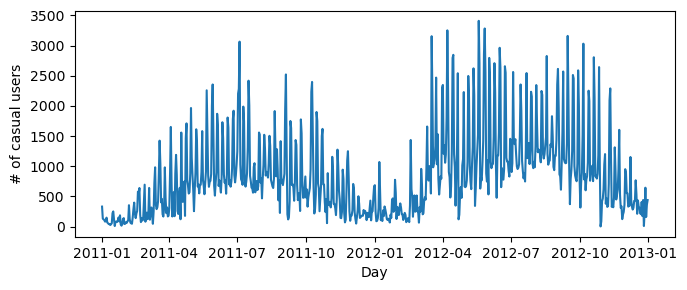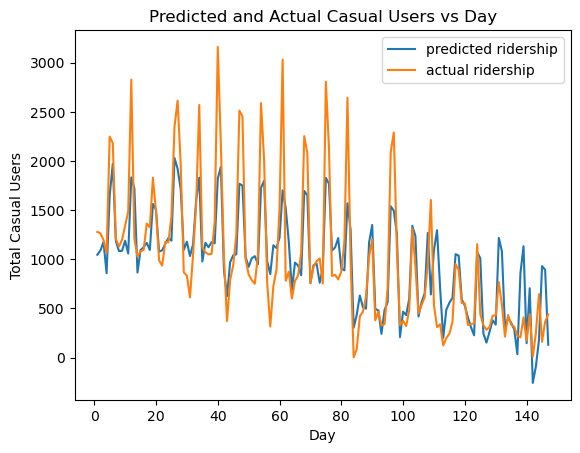%load_ext autoreload
%autoreload 2Linear Regression Implementation
Here is the link to my source code: Linear Regression
Least-Squares Linear Regression
For this blog post, I’ve implemented least-squares linear regression in two ways: using the analytical method and an efficient gradient descent.
Analytical Method
The analytical method is derived from solving the equation: \[0 = X^{T}(X \hat{w} - y)\]
where \(X\) is our paddded feature matrix. By setting the gradient equal to \(0\), we can solve for \(\hat{w}\) to get an explicit solution for the optimized weight vector. Solving this equation requires \(X\) to be an invertible matrix such that it has at least many rows as columns. Thus, our final solution for \(\hat{w}\) is
\[\hat{w} = (X^{T}X)^{-1} X^{T}y\]
In my fit_analytic method, I utilized numpy’s linalg transpose and inverse methods alongside orderly matrix multiplications to calculate the optimized weight vector \(\hat{w}\).
Efficient Gradient Descent
To implement an efficient gradient descent for least-squares linear regression, instead of computing the original gradient equation at each iteration of an epoch:
\[\nabla{L(w)} = X^{T}(Xw - y)\]
I calculated once \(P = X^{T}X\) and \(q = X^{T}y\) to reduce the time complexity of the matrix mutliplication of \(X^{T}X\) being \(O(np^2)\) and \(X^{T}y\) being \(O(np)\). Thus, reducing the gradient equation to be:
\[\nabla{L(w)} = Pw - q\]
reduces the time complexity of calculating the gradient to be \(O(p^2)\) steps which is significantly faster! In my fit_gradient method, I first initialized some random weight vector of \(p\) shape as my padded \(X\) feature matrix. Then, I computed \(P\) and \(q\) which I used inside my for-loop to update my weight vector \(self.w\) with the gradient. At each epoch, I calculated the score of the current weight vector and appended the current score to score_history.
Experiments
Demonstration
Shown below, I’ve generated a set of data using the LR_data method in my LinearRegression class. Then, I fit the data using both analytic and gradient descent methods and should expect a similar optimized weight vector \(w\).
from linear import LinearRegression
import numpy as np
from matplotlib import pyplot as plt
LR = LinearRegression()
def pad(X):
return np.append(X, np.ones((X.shape[0], 1)), 1)
def LR_data(n_train = 100, n_val = 100, p_features = 1, noise = .1, w = None):
if w is None:
w = np.random.rand(p_features + 1) + .2
X_train = np.random.rand(n_train, p_features)
y_train = pad(X_train)@w + noise*np.random.randn(n_train)
X_val = np.random.rand(n_val, p_features)
y_val = pad(X_val)@w + noise*np.random.randn(n_val)
return X_train, y_train, X_val, y_valnp.random.seed(1)
n_train = 100
n_val = 100
p_features = 1
noise = 0.2
# create some data
X_train, y_train, X_val, y_val = LR_data(n_train, n_val, p_features, noise)
# plot it
fig, axarr = plt.subplots(1, 2, sharex = True, sharey = True)
axarr[0].scatter(X_train, y_train)
axarr[1].scatter(X_val, y_val)
labs = axarr[0].set(title = "Training", xlabel = "x", ylabel = "y")
labs = axarr[1].set(title = "Validation", xlabel = "x")
plt.tight_layout()
LR.fit_analytic(X_train, y_train)
print(f"Training score = {LR.score(X_train, y_train).round(4)}")
print(f"Validation score = {LR.score(X_val, y_val).round(4)}")Training score = 0.4765
Validation score = 0.4931LR2 = LinearRegression()
LR2.fit_gradient(X_train, y_train, alpha = 0.01, max_iter = int(1e2))Then, I can plot the score_history of the gradient descent to see how the score evolved until the max iterations. By observation, the score evolved monotonically since we’re not using stochastic gradient.
plt.plot(LR2.score_history)
labels = plt.gca().set(title = "Evolution of Training Score", xlabel = "Iteration", ylabel = "Score")
Experiment 1: Increasing p_features with constant n_train
For this first experiment, I’ve chosen to increase the number of p_features to \(10\), \(50\), and then later choose the number of p_features to be \(n-1\).
np.random.seed(4)
n_train = 100
n_val = 100
p_features = 10
noise = 0.2
# create some data
X_train, y_train, X_val, y_val = LR_data(n_train, n_val, p_features, noise)# Use our fit_analytic method to get training and validation score
LR1 = LinearRegression()
LR1.fit_analytic(X_train, y_train)
LR1_train_score = LR1.score(X_train, y_train).round(4)
LR1_validation_score = LR1.score(X_val, y_val).round(4)np.random.seed(2)
p_features = 50
X_train, y_train, X_val, y_val = LR_data(n_train, n_val, p_features, noise)# Use our fit_analytic method to get training and validation score
LR2 = LinearRegression()
LR2.fit_analytic(X_train, y_train)
LR2.fit_analytic(X_train, y_train)
LR2_train_score = LR2.score(X_train, y_train).round(4)
LR2_validation_score = LR2.score(X_val, y_val).round(4)np.random.seed(3)
p_features = n_train - 1
X_train, y_train, X_val, y_val = LR_data(n_train, n_val, p_features, noise)# Use our fit_analytic method to get training and validation score
LR3 = LinearRegression()
LR3.fit_analytic(X_train, y_train)
LR3_train_score = LR3.score(X_train, y_train).round(4)
LR3_validation_score = LR3.score(X_val, y_val).round(4)We can visualize the training and validation scores to visibly observe the differences of each experiment as we increase the number of p_features.
# Code from https://www.geeksforgeeks.org/bar-plot-in-matplotlib/
bar_width = 0.2
training_scores = [LR1_train_score, LR2_train_score, LR3_train_score]
validation_scores = [LR1_validation_score, LR2_validation_score, LR3_validation_score]
# Set position of bar on X axis
br1 = np.arange(len(training_scores))
br2 = [x + bar_width for x in br1]
# Make the plot
plt.bar(br1, training_scores, width = bar_width,
edgecolor ='grey', label ='training score')
plt.bar(br2, validation_scores, width = bar_width,
edgecolor ='grey', label ='validation score')
plt.title('Number of p_features vs score with constant n_train')
# Adding Xticks
plt.xlabel('Number of p_features', fontsize = 12)
plt.ylabel('Score', fontsize = 12)
plt.xticks([r + 0.1 for r in range(len(training_scores))],
['10', '50', 'n_train - 1'])
legend = plt.legend()
plt.show()
As shown on the graph above, we can see that as the number of p_features increases up to n_train - 1, the fitted model’s training_score also increases. However, the model’s validation score decreases. This conclusion is related to the model being overfit due to the significant difference of the training and validation score between the model with n_train - 1 p_features. This means that we’ve trained the model exactly to some random training data given, however, when validated on the true labels, the calculated optimized weight vector \(w\) will be highly inaccurate in comparison to the labels.
Experiment 2: LASSO Regularization
Using LASSO regularization, we modify the original loss function to add a regularization term:
\[L(w) = ||Xw - y||^{2}_{2} + \alpha||w'||_{1}\]
This extension of the regularization term minimizes the weight vector \(w\) as small as it could be and forces the weight vector’s entries to be exactly zero.
Varying Degrees of Alpha
For this experiment, we can choose varying degrees of alpha while increasing the number of p_features of our data.
from sklearn.linear_model import Lasso# Alpha of 0.001
L1 = Lasso(alpha = 0.001)p_features = 10
# Fit our model
X_train, y_train, X_val, y_val = LR_data(n_train, n_val, p_features, noise)
L1.fit(X_train, y_train)
L1_validation_1 = L1.score(X_val, y_val)p_features = 50
# Fit our model
X_train, y_train, X_val, y_val = LR_data(n_train, n_val, p_features, noise)
L1.fit(X_train, y_train)
L1_validation_2 = L1.score(X_val, y_val)p_features = n_train - 1
# Fit our model
X_train, y_train, X_val, y_val = LR_data(n_train, n_val, p_features, noise)
L1.fit(X_train, y_train)
L1_validation_3 = L1.score(X_val, y_val)After fitting the Lasso model with an alpha of \(0.001\), we can plot its validation scores in contrast to the standard linear regression.
bar_width = 0.2
lasso_validation = [L1_validation_1, L1_validation_2, L1_validation_3]
linear_validation = [LR1_validation_score, LR2_validation_score, LR3_validation_score]
# Set position of bar on X axis
br1 = np.arange(len(lasso_validation))
br2 = [x + bar_width for x in br1]
# Make the plot
plt.bar(br2, linear_validation, width = bar_width,
edgecolor ='grey', label ='standard linear regression')
plt.bar(br1, lasso_validation, width = bar_width,
edgecolor ='grey', label ='lasso regularization')
plt.title('Number of p_features vs Validation Score for Lasso Regularization and Standard Linear Regression')
# Adding Xticks
plt.xlabel('Number of p_features', fontsize = 12)
plt.ylabel('Validation Score', fontsize = 12)
plt.xticks([r + 0.1 for r in range(len(lasso_validation))],
['10', '50', 'n_train - 1'])
legend = plt.legend()
plt.show()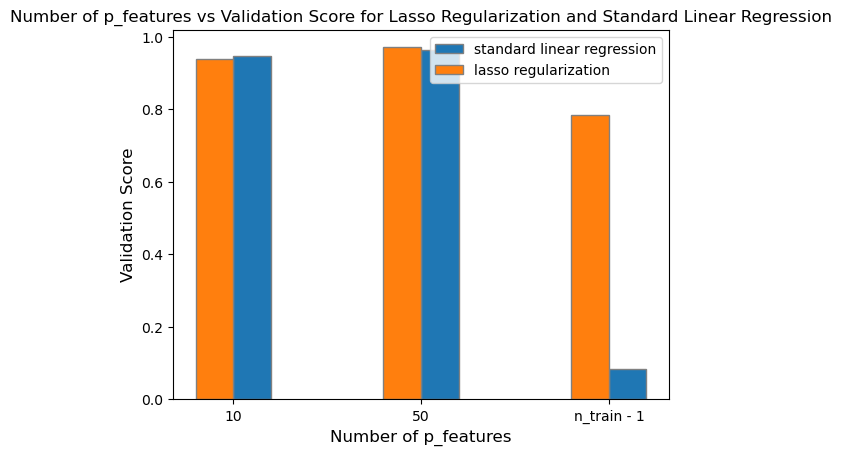
# Alpha of 0.01
L2 = Lasso(alpha = 0.01)p_features = 10
# Fit our model
X_train, y_train, X_val, y_val = LR_data(n_train, n_val, p_features, noise)
L2.fit(X_train, y_train)
L2_validation_1 = L2.score(X_val, y_val)p_features = 50
# Fit our model
X_train, y_train, X_val, y_val = LR_data(n_train, n_val, p_features, noise)
L2.fit(X_train, y_train)
L2_validation_2 = L2.score(X_val, y_val)p_features = n_train - 1
# Fit our model
X_train, y_train, X_val, y_val = LR_data(n_train, n_val, p_features, noise)
L2.fit(X_train, y_train)
L2_validation_3 = L2.score(X_val, y_val)After fitting the Lasso model with an alpha of \(0.01\), we can plot its validation scores in contrast to the standard linear regression.
bar_width = 0.2
lasso_validation = [L2_validation_1, L2_validation_2, L2_validation_3]
linear_validation = [LR1_validation_score, LR2_validation_score, LR3_validation_score]
# Set position of bar on X axis
br1 = np.arange(len(lasso_validation))
br2 = [x + bar_width for x in br1]
# Make the plot
plt.bar(br2, linear_validation, width = bar_width,
edgecolor ='grey', label ='standard linear regression')
plt.bar(br1, lasso_validation, width = bar_width,
edgecolor ='grey', label ='lasso regularization score')
plt.title('Number of p_features vs Validation Score for Lasso Regularization and Standard Linear Regression')
# Adding Xticks
plt.xlabel('Number of p_features', fontsize = 12)
plt.ylabel('Validation Score', fontsize = 12)
plt.xticks([r + 0.1 for r in range(len(lasso_validation))],
['10', '50', 'n_train - 1'])
legend = plt.legend()
plt.show()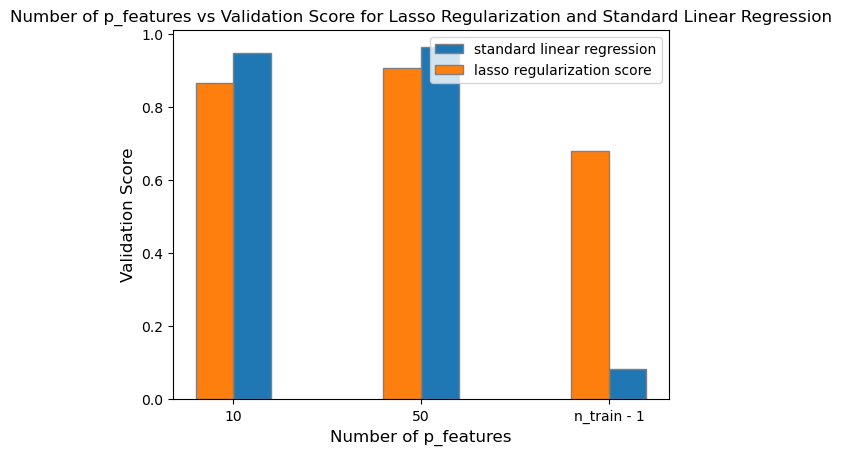
# Alpha of 0.1
L3 = Lasso(alpha = 0.1)p_features = 10
# Fit our model
X_train, y_train, X_val, y_val = LR_data(n_train, n_val, p_features, noise)
L3.fit(X_train, y_train)
L3_validation_1 = L3.score(X_val, y_val)p_features = 50
# Fit our model
X_train, y_train, X_val, y_val = LR_data(n_train, n_val, p_features, noise)
L3.fit(X_train, y_train)
L3_validation_2 = L3.score(X_val, y_val)p_features = n_train - 1
# Fit our model
X_train, y_train, X_val, y_val = LR_data(n_train, n_val, p_features, noise)
L3.fit(X_train, y_train)
L3_validation_3 = L3.score(X_val, y_val)After fitting the Lasso model with an alpha of \(0.1\), we can plot its validation scores in contrast to the standard linear regression.
bar_width = 0.2
lasso_validation = [L3_validation_1, L3_validation_2, L3_validation_3]
linear_validation = [LR1_validation_score, LR2_validation_score, LR3_validation_score]
# Set position of bar on X axis
br1 = np.arange(len(lasso_validation))
br2 = [x + bar_width for x in br1]
# Make the plot
plt.bar(br2, linear_validation, width = bar_width,
edgecolor ='grey', label ='standard linear regression')
plt.bar(br1, lasso_validation, width = bar_width,
edgecolor ='grey', label ='lasso regularization')
plt.title('Number of p_features vs Validation Scores for Lasso Regularization and Standard Linear Regression')
# Adding Xticks
plt.xlabel('Number of p_features', fontsize = 12)
plt.ylabel('Validation Score', fontsize = 12)
plt.xticks([r + 0.1 for r in range(len(lasso_validation))],
['10', '50', 'n_train - 1'])
legend = plt.legend()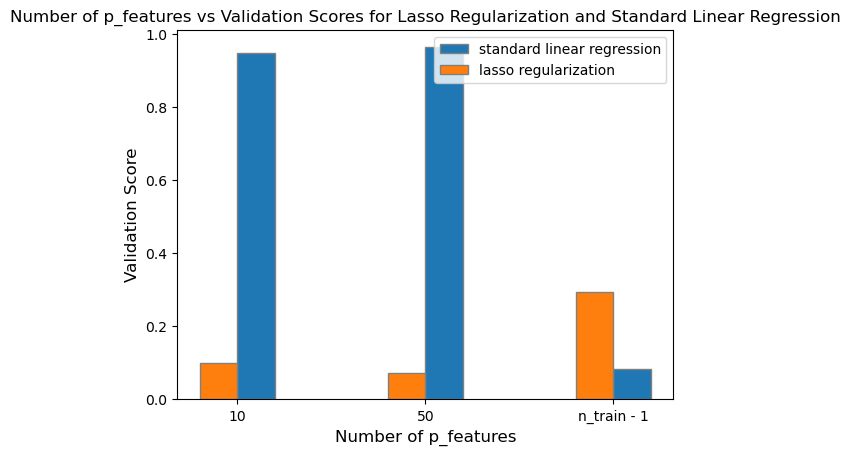
# Plotting all three alpha levels
bar_width = 0.2
lasso_validation_1 = [L1_validation_1, L1_validation_2, L1_validation_3]
lasso_validation_2 = [L2_validation_1, L2_validation_2, L2_validation_3]
lasso_validation_3 = [L3_validation_1, L3_validation_2, L3_validation_3]
# Set position of bar on X axis
br1 = np.arange(len(lasso_validation_1))
br2 = [x + bar_width for x in br1]
br3 = [x + bar_width for x in br2]
# Make the plot
plt.bar(br1, lasso_validation_1, width = bar_width,
edgecolor ='grey', label ='alpha = 0.001')
plt.bar(br2, lasso_validation_2, width = bar_width,
edgecolor ='grey', label ='alpha = 0.01')
plt.bar(br3, lasso_validation_3, width = bar_width,
edgecolor ='grey', label ='alpha = 0.1')
plt.title('Number of p_features vs Validation Score for Lasso Regularization with Varying Alpha Degrees')
# Adding Xticks
plt.xlabel('Number of p_features', fontsize = 12)
plt.ylabel('Validation Score', fontsize = 12)
plt.xticks([r + 0.1 for r in range(len(lasso_validation))],
['10', '50', 'n_train - 1'])
legend = plt.legend()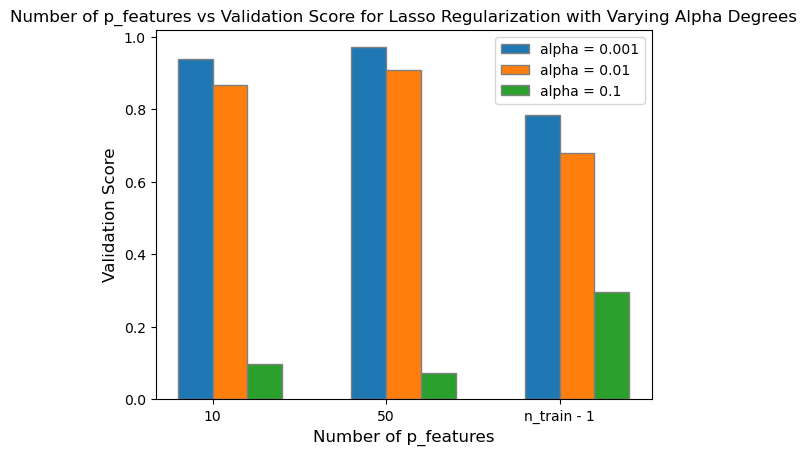
After plotting all three degrees of alpha with increasing number of p_features up to n_train - 1, I found that smaller values of alpha (alpha = \(0.001\)) will still retain a moderately high validation score despite reaching up to n_train - 1 number of p_features. However, as I increase the degree of alpha to \(0.01\) and \(0.1\), the difference in validation score between LASSO regularization and standard linear regression becomes significantly different. As I increase the strength of the regularizer, the validation score for LASSO regularization approaches zero, and is no longer accuracte in predicting the true labels.
In conclusion, LASSO regularization can improve a model’s validation score with smaller alpha levels in contrast to utilizing standard linear regression even with up to n_train - 1 number of p_features. However, as you increase the strength of the regularization, the validation score decreases significantly, and the model is no longer proficient in its predictions.
